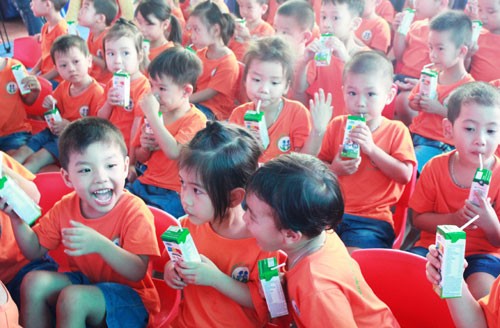(VOVworld) – Bac Ninh province has spent more than 7.9 million USD on a school milk program to improve the health of preschool children. For 3 years the program has been reducing the number of malnourished, underweight, and stunted children.
 |
| Children of Hoa Sen Kindergarten in Thua Town, Luong Tai district at the launch of the 2016 School Milk Program in September 2016. (Photo: baobacninh.com.vn) |
First piloted in September, 2013, at 24 kindergartens in Bac Ninh, the school milk program proved effective in its first year. During the previous academic year, the program was expanded to all preschools in the province.
Ngo Thi Thu Huong, Vice Principal of Sao Mai Kindergarten, noted: “This academic year is the third year Sao Mai Kindergarten has been operating and also the third year the school’s children have benefited from the milk program. Drinking milk helps children develop in mental acuity, physical strength, and height.”
Thanh Khuong Kindergarten in Thuan Thanh district was one of the first schools in Bac Ninh to implement the program. Cao Thi Hoe, the school’s Principal, said the program has been enthusiastically praised by the children’s parents.
“Drinking milk has helped the children grow taller. The parents pay just 25% of the cost of the milk, but their child can drink milk three times a week. This makes the parents enthusiastic about the program,” said Hoe.
Nguyen Giang Long, a parent from Bac Ninh City, said the program provides better nutrition and micro-nutrients to the children.
He said: “The program is good. In European countries, drinking milk regularly gives children better health. We feel more secure.”
Trinh Khoi, Deputy Director of the provincial Education and Training Department, said: “In this school year, more than 86,000 preschool children have benefited from the program. Effective implementation of the school milk program annually reduces the number of malnourished and underweight children to 2.5% and the number of stunted children to 1.6%. We’ve recommended that the provincial administration continue the program in kindergartens and expand it to primary schools.”